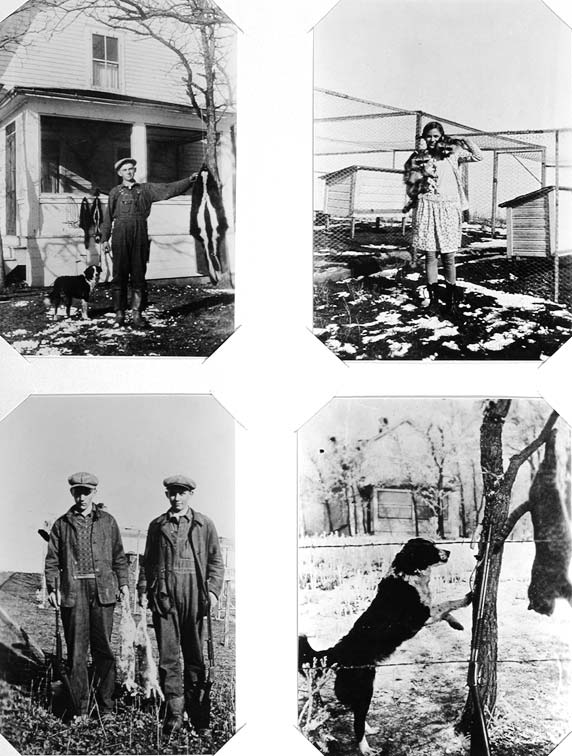Fur Farming Fever
Top left: Donald and Perley with three skunk hides from the 1930-1931 trapping season. The mail order hip boots cost $7. "They were my pride and joy and I treated them better than my Sunday suit." The "big" skunk hide is hung several feet in front of his hand to make it look bigger -- trick photography!
Top right: Marjory with raccoons Su and Lu (1930) at fur farm pens. She had to feed "his" animals. Still, her tan stockings (with knee wrinkles) mark another hard-won victory.
Bottom left: Howard Melby and Donald, rabbit hunt (1931).
Bottom right: "End of the Chase" -- Donald and/or Marjory's title -- (1932). Stray tomcats killed kittens on the farm so Donald shot them when he could. Perley learned to tree them and is posed here with the prey. Note the carefully arranged setup.
Excerpt from Donald B. Johnson manuscript:
"My main interest during my teen years, when I was almost completely isolated from the world, was trapping: skunks, 'coons, mink, weasels, and (mostly) muskrats. But I mostly trapped on our own land and the volume was limited.
"Fur farming was a new industry that was just getting started, so I thought that's what I would do. I sent for every fur magazine and fur farm equipment catalog I could find and had visions of all the hillsides covered with steel pens full of every kind of fur animals, like the pictures I had seen in the magazines.
"Everyone had the fur farming fever. People all over the country were starting out with wild-caught animals for breeding stock. "Fur was considered real high then (1924 to 1928): $1.50 for average muskrats, $8 for raccoons, $20 for mink and silver fox. Breeding stock was selling for $1,500 a pair!
"The summer I was 14 [1927] I ordered two steel pens to raise 'coons in and built four double mink cages and had a pair of young 'ranch-raised' 'coons shipped down from Park Rapids for $25 a pair. I bought a pair of 'wild caught' mink from Andy Bjork from Battle Lake for $25 each. Their teeth were all broken off from biting the traps, but they were okay that year. The next year the male died and I got another one shipped from North Dakota. He was from 'Super Ranch-Raised Extra Dark' Alaskan stock. I paid $35 for him. Extra cheap because another mink had bit his tail off when he was a 'kit' -- $50 was the usual price.
"I got another wild-caught female raccoon up by Erhard. I rode along with Nels Eian, Sr. on a fur buying trip and got that one for $10. She had young ones the next spring, but she was nervous and killed a couple of them when they were a couple of weeks old. We rescued the other two and fed them with a spoon.
"In two years I had increased them to 10 mink and 11 'coons, but then the Depression hit and they were hardly worth skinning. We skinned them all anyway, but that was the end of my fur-farming dream. Several years later I managed to sell my pens to a big fur farmer at Pelican Rapids for 60 percent of what they cost, which was the same cut people with money in the bank took when the banks closed."
Previous • Next • Contents • About • Sitemap • Home
